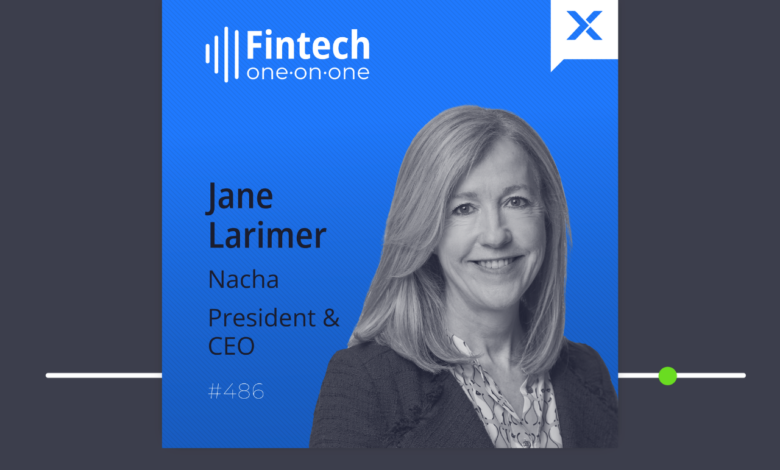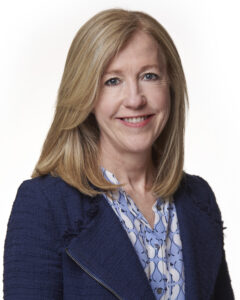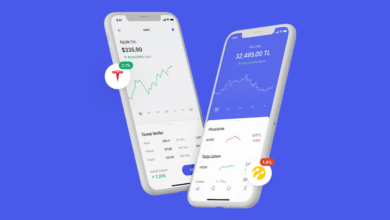Jane Larimer, President & CEO of Nacha, on operating the largest payments network

Enjoying our podcasts? Don’t miss out on future episodes! Please hit that subscribe button on Apple, Spotify, YouTube, or your favorite podcast platform to stay updated with our latest content. Thank you for your support!

The largest payments network by volume is the ACH network. A dollar value of several times US GDP flows through the network each quarter. It is a 50-year-old network that is reliable, ubiquitous, and still growing. While several shiny new payment rails have been developed, the workhorse of the economy remains ACH and will remain so for some time.
My next guest on the Fintech One-on-One podcast is Jane Larimer, the President and CEO of Nacha, the organization that governs the ACH network. While I often feature people on this show to talk about cool and emerging technology, I also think it is critical that we understand the infrastructure that is in place today. And the ACH network is how the vast majority of payments are made.
In this podcast you will learn:
- The origin story of the ACH network.
- The first use case for the network.
- How they moved from paper checks to electronic payments.
- The mission of Nacha.
- Why some banks become direct members of Nacha.
- The staggering scale of the payments flowing through the ACH network.
- How the timing works for payments on the ACH network.
- Why the ACH network is unable to process payments on weekends (but that may be changing)
- Jane’s perspective on instant payments and why she believes it is complementary to ACH.
- The cost difference between Same Day ACH and standard ACH.
- The big barrier to the adoption of any alternative payment rails.
- How fraud has changed in the past decade.
- Details of the education available on their website.
- How Jane sees the future of payments playing out over the next decade.
Read a transcription of our conversation below.
Peter Renton 00:01
Welcome to the Fintech One-on-One podcast. This is Peter Renton, Chairman and co-founder of Fintech Nexus. I’ve been doing this show since 2013, which makes this the longest running one-on-one interview show in all of fintech. Thank you so much for joining me on this journey.
Peter Renton 00:27
Today on the show, I am delighted to welcome Jane Larimer. She is the CEO and President of Nacha. So what is Nacha? It is the organization that manages and governs the ACH network. So sometimes I think in fintech, we focus on this new shiny object, and we don’t really understand the what has come before, or what is really dominating the financial space right now. And that’s one of the reasons why I wanted to get Jane on the show to talk about Nacha and the ACH network, the scale of the payments that flow through this network is truly staggering, we talk about that. We also talk about how the, how it works. What’s the difference between same day ACH and regular ACH. Jane gives her perspective on real time payments, FedNow and RTP. She also talks about some of the alternative payment rails and what she thinks there. We talk about anti fraud, education, and much more. It was a fascinating discussion. Hope you enjoy the show.
Peter Renton 01:35
Welcome to the podcast, Jane.
Jane Larimer 01:37
Well, Peter, I’m delighted to be here. Thank you for having me.
Peter Renton 01:40
My pleasure. So let’s kick it off by giving the listeners some background. When I looked at your LinkedIn profile, you’ve been at Nacha for a long time, it seems like, most of your career. So can you just tell us some of the some of the highlights, what you’ve done inside that organization over the last several decades, shall we say?
Jane Larimer 02:03
Exactly. So I was hired in as a very junior attorney at Nacha. They’d never had in house counsel before. I’d had a few years working at a financial institution before that. And so I came in, and they said, Learn how everything works. And I worked on check conversion, which is turning checks into ACH payments, I worked on electronic benefits transfer, worked on so many different things, because they just wanted me to learn everything. So it was kind of, as opposed to a lot of lawyer jobs, it was just get out there and travel and meet our members and work on these big issues of interest to the industry. So I did that and became general counsel. And about 20 years ago, at that point, they said, you know how the network works, you know, the business side of it, and the legal side of it. And so I became the head of the network, the ACH network at the same time, as being general counsel, from there chief operating officer and then the CEO five years ago.
Peter Renton 03:04
Okay. So I’d like you to kind of take us back through some of the history of the ACH payments network. And is it 50 years this year? So that’s been obviously a very well established network. What were the origins? And how did Nacha begin?
Jane Larimer 03:24
The origin story is the Department of Defense was looking for an electronic or digital alternative to checks. Because one of their airplanes went down that, you know, sacks of checks used to be flown around. And suddenly they were looking for an alternative to that, and a group of financial institutions, bankers, the Federal Reserve, and others got together and created the framework for The Clearing House, the automated clearing house. And at the time, there were four regional payments associations, we call it sort of four clearing houses for ACH transactions, and those four clearing houses, joined forces to create a national Automated Clearing House Association. So the national infrastructure, so that we would have one national rule set over the United States as opposed to having different rule sets through different automated clearing houses.
Peter Renton 04:25
I imagined initially it was just processing checks, right?
Jane Larimer 04:27
The whole use case was electronic. So it was, as you think of direct deposit, that was the first use case. It was the alternative to the check. So as opposed to a piece of paper, and they were I think magnetic tapes at the time, but they created this electronic or digital alternative to checks so that you wouldn’t have to fly at chuck all over the country. You could just move the data. So the idea was for them to create the rule set to move the data from place to place, and that was direct deposit. It also in the 70s, direct payment. So what you think of your mortgage payment might be paid today, or your electric bill, you know that when people, when money is pulled from your account, that’s direct payment, when money is pushed to you, it’s direct deposit. And also then, in the 70s, business to business transactions were created too. So all of these were created to move from paper into electronics.
Peter Renton 05:30
Right. And then you said, like you were working on the sort of check to digital conversion, like, I remember back in, I think it was God, probably 20, 20 plus years ago, in my one of my former companies, we had a check scanning machine that would go through and process all the checks that would come in, and that was sort of how we would do our deposits. So tell us a little bit about that technology.
Jane Larimer 05:53
In the late 90s, paper was still very expensive, it was still being flown around. And they were looking at ideas to move from that paper, say at the point of sale, or at the lockbox, convert those to electronic and get the paper out of the system. So we created pilots with the industry. One was a lockbox check conversion. So taking the data off the checks stripping it off the check and moving it through the ACH. Another one was called the point of purchase check conversion. And that was when you went into a grocery store at the point of sale, they would read your check, take all that information off the micro line off the bottom, and they would then you’d authorize an ACH payment and you’d get your check back. So those transactions were called check conversion transactions, and really the lockbox transaction that we were talking about, so that’s a transaction where you pay your bill via mail, and somebody opens up the lockbox, they open up the envelope, they take the check, and they convert it into ACH. That was one of the big volume drivers for the ACH network back in the early 2000s.
Peter Renton 07:06
Interesting, interesting. Okay, so then what is the mission of Nacha and and how’s that mission evolved over the last 50 years?
Jane Larimer 07:15
So the mission of Nacha is to govern the ACH network. So we write the rules, we have risk management and the national system of fines. So we enforce the rules for the ACH. And our mission is to create with the industry, a vibrant growing, ACH network. So we work to, if there are barriers to use the network, or if there’s things that we need to do to innovate or evolve the network, we work with the industry to do that. In addition to that, we also we have this expertise, clearly in bringing the industry together to create rules and standards. So we’ve used that expertise in other ways to bring people together to move from paper food stamps to a card based electronic benefits transfer system for instance, that was in the late 90s, early 2000s. We’ve used it to bring people together to create standardized APIs for the financial services industry. That’s, what 25 years later, after the EBT work. So we always have had this mission, not just for the ACH but to use our talents and our resources to bring the industry together to create standards and interoperability wherever there’s a need.
Peter Renton 08:34
Right, right. Do you have 100% coverage,right? Every bank and credit union in the country is is part of the ACH network, right?
Jane Larimer 08:42
Yeah, so I will say virtually just in case there’s somebody in an outpost somewhere that isn’t, but yes.
Peter Renton 08:49
Okay. Okay. But then you also have direct members of Nacha. What does that mean, and why do banks become members?
Jane Larimer 08:59
So we have direct members of Nacha. And there there are two kinds of members. One, our regional payments association. Our payments associations are associations that have their own memberships of members, and so our payments associations, they actually when they come as members of Nacha, they have hundreds or 1000s of financial institutions that are their members. So that’s one side, and then we have financial institutions that can become directly involved with Nacha and direct members of Nacha. And why they do that because they, at that point, they can have a vote on the Nacha operating rules like the payments associations do. They are part of our councils and our groups so they can work on helping to develop the ACH system. So what I think is really great is between our payments associations and our direct members, when we put a rule out for voter rule at the ballot, you have have the strength of the vast majority of financial institutions in the United States voting on those rules.
Peter Renton 10:06
Right, right. I want to I want to talk about scale, because I was looking at your first quarter report. It’s staggering to me the scale that that goes through the ACH network, and let me just quote it here. 8.2 billion payments in the first quarter, 47% increase in same day ACH. But the thing that was most staggering to me was the total value of value, $20.7 trillion. Now, I think US GDP is running, I think it’s like 24/25 trillion, but this is more, this is just one quarter. So more, several times US GDP, flowing through the ACH network. It’s truly staggering. How have you been able to grow, and it’s still growing, like you said, was five plus percent growth faster than actual economy, the economy is growing. What do you attribute to that?
Jane Larimer 11:01
Well, you know, we say that the ACH network is the backbone of the economy of the United States, and we really mean that. We have, when you think about those payments, it’s everything from, as we talked about earlier, your electric, your electric bill being paid, or your mortgage, or your student loan, or, you know, those kinds of regular payments, everything from that, to business to business payments, and like big trading partner payments, so really large payments. We do some card settlement on the network, and the government that the US government is a huge user of the ACH network. And the reason why they use it is, and why people really love using the network is, it is economical, it is, it’s this workhorse. So we call it industrial strength, because I mean, it is, it’s always there, it’s always on, and it’s moving these big batches of payments through the network. So it’s very, it’s, you know, it’s certain, it’s secure, and it’s very efficient.
Peter Renton 12:04
Can you explain how the process actually works? Would love to kind of get a sense of the technology that goes through, and particularly with the, there’s regular ACH, and then obviously, you now have same day ACH. How does the technology work? Are these, do batch that up and run it like six times a day? How does it work?
Jane Larimer 12:25
So right now, we have three, same day windows a day, and then our standard is settlement. So if you think about classic ACH, that would be your overnight payment cycle. So payments are batched throughout the day, there might be moved off, but then they clear and settle overnight. That’s kind of your your plain, vanilla ACH. We have three same day windows, morning, early afternoon and late afternoon, where you can move intraday payments. So it depends on what the sender wants to do. How quickly transactions move through the ACH network is based on the design of the person sending or the entity sending the payment. So for instance, for payroll, oftentimes, the employer mean, they move, they’re big, you know, think about a big company, a multinational company who has 10s of 1000s of payroll payments, they’re making that payroll overnight, right, they don’t, but if, for instance, they have some employees that want to be paid daily, or in the afternoon, they could use the same day window to be doing that. Or if you have a just in time payment, I want to make my credit card payment today and credit card company decides, Okay, so she made her payment, say I want to collect it today, they can use the same day window to collect it. So it’s really based on, you know, when the either a consumer gets an authorization or when the sender of the payment, how fast they decide they want the payment to move.
Peter Renton 14:04
So why do you only process given that this is all electronic, why do you only process during the week? Why don’t you just run these things 24/7?
Jane Larimer 14:12
It’s interesting. So right now the operators, the ACH operators, there’s two of them, the Federal Reserve and The Clearing House is EPN. They can collect payments throughout the day. So the financial institutions may be sending to them throughout the day, but the ACH network itself can only settle transactions when the national settlement service is open. So right now the national settlement service is not open service is not open 24/7/365. So we can’t be open, either because we have to have those two ACH operators settle together.
Peter Renton 14:50
Gotcha.
Jane Larimer 14:51
So as they look at expanding the national settlement service, we could look at expanding the hours of the ACH network.
Peter Renton 14:58
Right, right there all competing networks now now we have The Clearing House, RTP, you’ve got FedNow. Obviously, the scale of these networks are miniscule, compared to what’s running through ACH. But do you have an official perspective on these real time payments, then of course you’ve got the card rails as well. What does Nacha’s official view on those things?
Jane Larimer 15:23
I’ll give you Jane’s opinion on that. My opinion on that is, I believe that users, end users, deserve a myriad of options. And sometimes you want to make a payment one way, and sometimes you want to make it more quickly. So for instance, I want to make my car payment every month using the ACH. But when I go to, you know, so it’s old faithful, it’s coming in directly debiting my account every month, I don’t have to do anything very convenient. But I go into say, sell my car, and the car showroom might say, Okay, well, an ACH debit isn’t the way we want to pay off your car, what we’d like to do is get an instant payment from you. We want a real time, irrevocable payment from you, we’d like to get it this way now. And now it’s a great thing for an instant payment system. So I think there’s different reasons why people use payments, instant payments, you know, instant meaning 24/7/365, it’s a revocable payment, so it can’t be pulled back. The ACH as we just discussed, it currently is not open 24/7. But I think there are reasons why people and companies want to use the ACH, and there’s reasons why they would want an instant payment. So I believe they’re complementary in that way. And I believe what we’ve seen over the past 15 years is just an explosion of the size of the pie of payments. You think back 15 years ago, or even five years ago to the number of payments you’re making, versus today, it’s completely different than it used to be, that pie is huge. And so I believe that having choice for end users is a good thing.
Peter Renton 17:19
Right? And you know, I just see in your first quarter report is a 47% increase in same day ACH volume. So clearly, there’s demand out there for that. So, but I imagine pricing wise, regular ACH is probably the cheapest form of payment there is right? And then, like same day, ACH is it double? I mean like, can you tell us, give us some sense of the pricing differences there?
Jane Larimer 17:43
So I can’t on price, and the costs are different. So to your point like what a traditional ACH through the operators is a fraction of a penny, a small fraction of a penny, and kind of a all in, depending on the relationship between the financial institution or customer, it may be according to AFP, the median cost of processing an ACH payment is 40 cents for an end user. So that gives you an idea. So how the financial institutions price out same day ACH to their customers, I don’t know, that’s between them.
Peter Renton 18:26
Obvisously it’s gonna vary, I imagine. There’s no national standard there, right?
Jane Larimer 18:28
Yes. You know, one of the things we’re seeing with same day ACH is, it has the network effect of the ACH, right? So every financial institution is a receiver by it’s nature. And then also, you know, end users corporates that want to use same day ACH, there’s not a lot of development they have to do, right. I mean, it’s the ACH system. So there’s an indicator that has to be changed. There’s a few things, but it’s just a much different lift. And I think that’s one of the reasons why we’ve seen the growth that we’ve seen so far, just because it’s a little bit right now, you don’t have quite that same lift to use it.
Peter Renton 19:09
Right. And there’s a lot of things like a recurring mortgage payment, there’s no need to use a same day ACH for that, right?
Jane Larimer 19:13
No, that’s exactly right.
Peter Renton 19:15
That’s a sticky product that’s probably going to stay ACH, overnight ACH standard for a long time.
Jane Larimer 19:24
I mean, the easiest ACH to use is the one where you set it and you never have to worry about it again, right? It’s debit that just comes out and you just, all you have to do is remember that you’re gonna be paying a mortgage, or your car payment, or whatever it is.
Peter Renton 19:36
Yep, yeah. And this goes on forever and, or until it’s paid off. I’d love to get your perspective on the different payments rails. I don’t know how much, how closely you watch some of the things that are happening in the blockchain space where you’ve got payments rails that are being, that are bypassing Visa, MasterCard rails, bypassing ACH rails, and just going on a completely different type of network. How much are you following that? Do you feel like that’s any kind of threat to to the ACH network at all?
Jane Larimer 20:11
So I follow it because it’s interesting, you know, so I’m trying to keep an eye on what’s happening out there. But I think network effects are really difficult to create. And a payments platform, like social media platforms, is a net above a network effect. That’s how we talked, and we talked earlier about scale. And so it’s not to say it can’t be done, it has been done you know PayPal, is a good example. Not a payment rail, per se, they use the payment rails, but there are ways to create this network effect. But it’s not easy in the payment space. And so if you’re, especially if you’re talking about, you know, getting money in and out of the system, again, so with some of these payment rails, it’s not truly and you can’t really get your money out, you have to use an existing payment rail to get your money back out. I think it’s interesting. I think it bears watching. And there’s a lot of cool things being done. As we look at kind of scale and the importance of network effects to creating scale, I think right now, just kind of in a watching position.
Peter Renton 21:23
Right, even like the new one like FedNow, I mean, I had Mark Gould on the show a couple of months ago. And he, he’s talking about there, the network effects there. It’s difficult, I mean, they’re growing quite rapidly as far as new banks going on, they’ve got the same challenge that any alternative payment network is going to have. And that’s backed by the federal government.
Jane Larimer 21:44
Yeah. And you know, it’s been, you think about it, Nacha’s here with the ACH network for the last 50 years. So you’ve had 50 years to create that. And I think it’s very early days right now. I mean, if you think about it, just to give you a kind of a pointer, in 2003, our volume was about 10 billion. So then 20 years later, it’s 30 billion. So I mean, it takes a while for it to create that, especially when you think about the United States where you have almost 10,000 financial institutions.
Peter Renton 21:44
Yeah, I mean, the United States is very unique. I mean, I’m originally from Australia where we have less than 100 financial institutions there. And it’s much, much simpler, obviously a much smaller economy as well. But anyway, I want to talk about fraud, because I’m curious about when it comes to ACH fraud, obviously the fraudsters have been attacking ACH for decades. And you’ve got that sort of, one of the beauties of ACH is you have that sort of clawback window, like you can get your money back if there has been a fraudulent transaction. But what do you see when it comes to fraud? And how closely are you monitoring what the fraudsters are doing, and how to how to counteract them?
Jane Larimer 23:02
You know, it’s a great question. And to your point, you know, we’ve been very, both careful and I think as proactive as we can be in the fraud space. So for the first, I don’t know my first, say for 15 years here or more, we were really looking at debit frauds. So remember, the thing that makes the ACH, interesting in this way is we both have, we both have the capability to do debit pulls, and credit pushes, right. So for a long time we were really focused on the debit space, and to your point, consumer, if they have an unauthorized debit, they can go to their financial institution and have that returned, that payment returned. So they’ve really good consumer protections there. And we spent a lot of time putting in rules and frameworks around debits to the extent that we could, made sure that that was a real, wholesome traffic in that space. The thing that’s changed in the last 10 years is credit push fraud. And I think everybody is, everybody within the financial services industries, is looking at this, it’s not just ACH, it’s on wires, you know, it’s on the instant payment rails, it’s anytime a credit push is being made. These are, and they’re harder, I think, in some ways. So it’s all the social engineering, kind of fraud. Or for businesses, it’s a vendor impersonation. So what we always say, one of our general best practices that we talk about on our website, to businesses is whenever you are changing an account number to somebody you are paying, that is a vulnerability. That is a time where that where fraudster can come in and give you bad information and you’re sending out the wire or the ACH or the check or the instant payment to them. So there are places within the system, you know what we always say is, Think about why you’re making this payment. If you are changing account information, that is a vulnerability, that’s where you need to make sure you have really good data. So we’ve spent a lot of time on our website producing education, best practices to try to help with that. We just recently passed rules surrounding our risk framework in the era of credit push fraud, nine new rules, which will be going effective over the next several years to try to help from prevention, you know, prevention all the way to remediation, for fraud. So we’re taking it very seriously, working with the industry to try to get our arms around this. And, you know, it’s one of those things where all the payment systems that are moving credits, you know we all have to be working to do our best against fraud. It is it’s a dynamic space.
Peter Renton 25:54
You mentioned the education on your website, I mean, it’s really, you have a huge amount of resources here. And obviously, you also got, you do in person events. But when people go to your website and look at the education, what is the most popular thing that people are looking to learn?
Jane Larimer 26:12
Well, I think there’s everything on our website from kind of the ACH 101, or payments 101. And that would be our Payments Institute, right, or our Payments Institute Homeschool. So these are things where it is trying to give you, give somebody kind of a learning, to give them a foundation in payments. So that’s you know, if your first exposures or you want to deepen your exposure in this big foundation of payments. We have some Master’s classes in that as well that are conferences, Smarter Faster Payments, that’s coming up soon and Remote Connect, that really gives you, it’s not just ACH, it’s instant, it’s card, it is everything that’s happening on the fraud front, on the, you know, on the emerging payments front, that is kind of a intensive, a few day intensive, where everybody’s together, and it’s networking. It’s the great conference environment. But for Nacha, our conference is not just great networking, and an exhibit hall, a trade show. But it’s also really good education, where we get experts within the industry to come and talk to us, and to explore different things, new ideas with people. So I think one of the things that sets, you know, Nacha and our conference off from others, apart from others, is the fact that it’s really, it does have that education focus, where you have really good meaty kind of cool sessions, not just a trade show. And lastly, accreditation. We believe that knowledge makes for better payment systems. So we have our, you know, our accredited ACH professionals, we have a risk professional accreditation, and we’re going to be having a Faster Payments professional accreditation, which is the instant payment rails and same day ACH. Because when you have people who are really good at what they do, and when they really understand the payment systems, and they really understand the risk of them, that makes for a better, you know, safer, more secure payment system. And it makes people’s houses, you know, their shops, and their financial institutions or in their corporations, it makes them better at what they do. So I think that for us is just a big win is to have smart, enthusiastic, knowledgeable people out there.
Peter Renton 28:32
Okay, so I want to close with a future looking question. And, you know, obviously, we’re going to see more and more instant payments. Obviously, ACH is by far the most well established payments form there is right now. But how do you see this playing out over the next decade shall we say?
Jane Larimer 28:51
Yeah, great, great question. So I agree with you, I believe instant payments are just going to grow, I think they’re going to be bringing more financial institutions onto those networks. I think there are more use cases that are gonna be out there. And there’ll be more folks who know that they have another choice. So I think that that’s great. So what I would say when I look at the future payments, is faster is definitely a part of that. And within faster is also expansions or same day ACH. So as we look at the national settlement service, potentially expanding the ACH can expand as well. And you know, I think at the end of the day, Peter one of the things that is forefront is you don’t always need a one off payment, a one off payment is great. A real, an instant payment is a one time payment. The ACH is this efficient, batch, we’re moving together, big volumes of payments, even if that moves more quickly and faster, you know, through whatever it’s a Saturday or a holiday, whatever. You still have the need for both this efficient kind of workhorse alongside an instant payment rail, so again I see, as we look at the future, these things being complementary to each other, and then what I’m really hoping for as we look at the future is, you know, will AI be helping to bring down exception processing? You know, can it make us have payments that are, where there’s less error potentially in it? And what are we looking at for, as you say, Fedwire and the national settlement service? You know, what are the other things that we’re going to be looking at as we move into the future, and it’s not just all about speed, it’s about data., and it’s about risk management and safety and soundness. So there’s a lot of other components that I think in over the next 10 years, it’s gonna be exciting.
Peter Renton 30:36
That is something I think we can all agree on. It is going to be exciting to watch. Anyway, Jane, thank you so much for coming on the show today. It was great to chat with you.
Jane Larimer 30:44
It was my pleasure. Thank you.
Peter Renton 30:48
Well I hope you enjoyed the show. Thank you so much for listening. Please go ahead and give the show a review on the podcast platform of your choice and go tell your friends and colleagues about it. Anyway, on that note, I will sign off. I very much appreciate you listening, and I’ll catch you next time. Bye.



